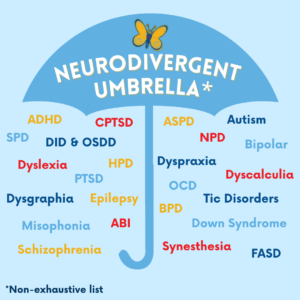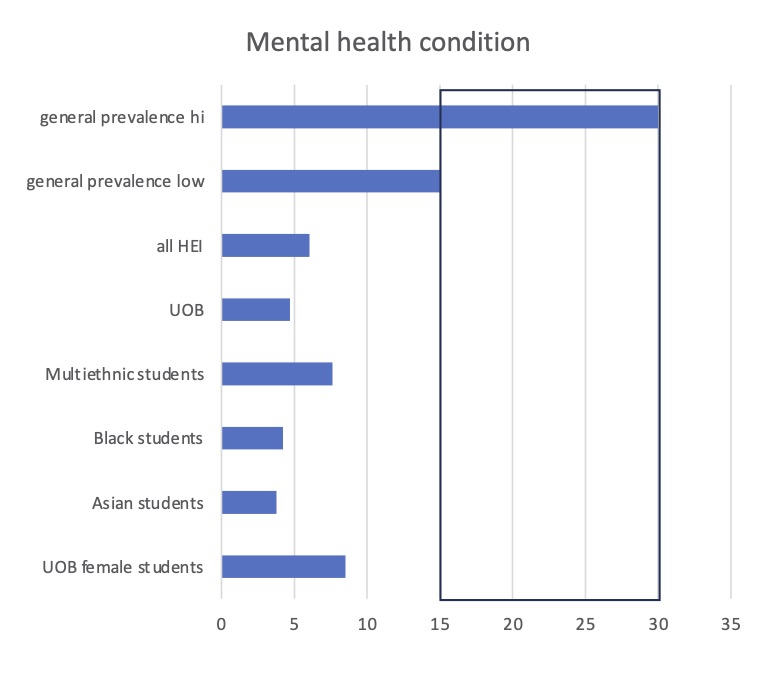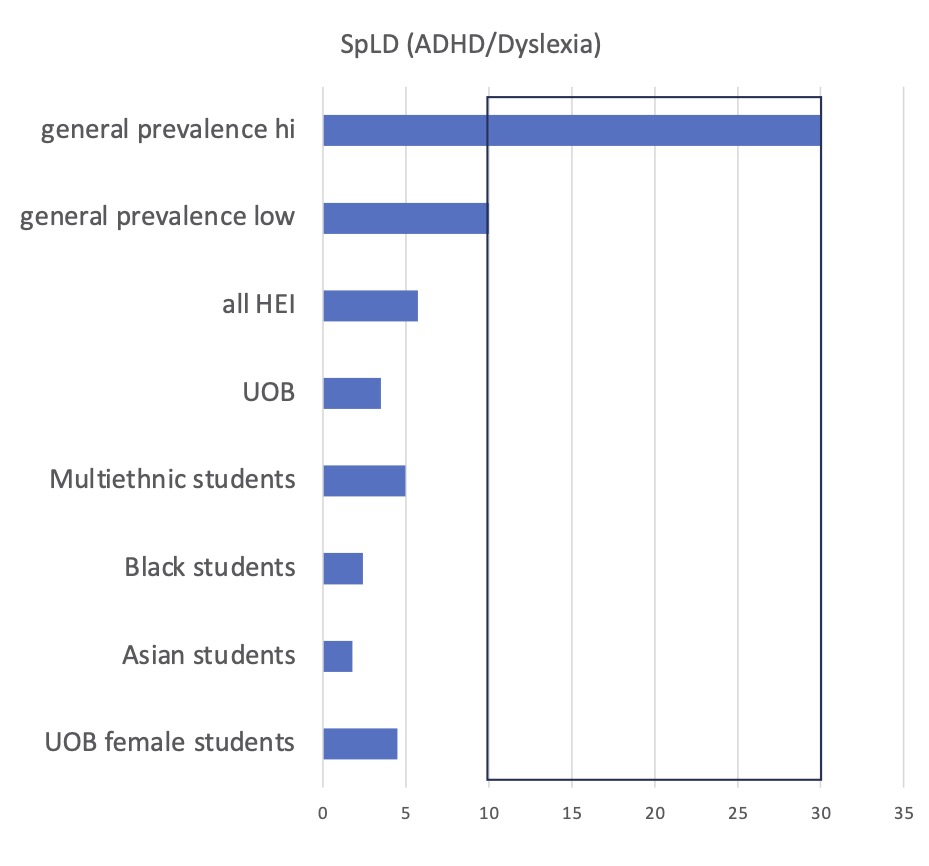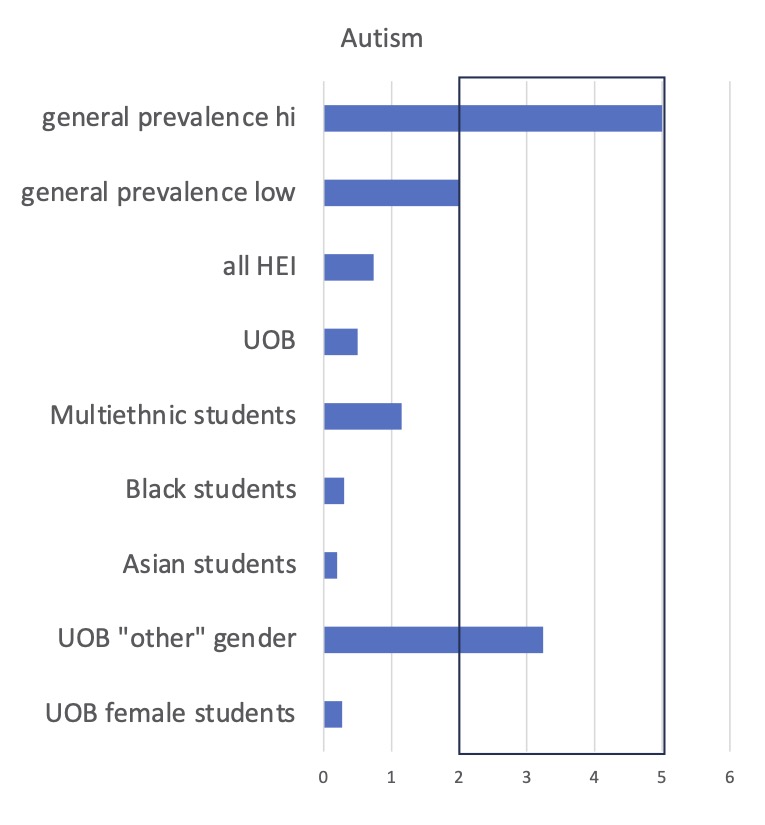Neurodiversity, Learning and Support in Philosophy
Jeremy Kidwell
12.06.002023
University of Birmingham
Presentation engineered with remark: https://github.com/gnab/remark/wiki
Follow along asynchronously online: (http://jeremykidwell.info/files/presentations/presentation-20230614-teaching_neurodiversity.html)
Content warning: suicide (slide 10), depression & anxiety, oppression, racialised and gendered forms of discrimination.
Why am I speaking about this?
- Since 2021, I have been running a tutorial with neurodiverse students, learning about student challenges and troubleshooting learning barriers
- I also have lived experience of neurodivergence
- And the various other bits: 20 years of working with experimental pedagogies and learning accommodation across various forms of cognitive and cultural difference, facilitating policy/impact workshops across forms of cognitive difference
- T&R Head of UG Programmes 2016-2019, PTR EDI Lead 2022-present
Neurodivergence at UOB - Summary
- neurodiversity = there are forms of cognitive difference which are salient to the way we work together, teach & learn
- These forms of difference are largely unacknowledged & unaccommodated (incidence stats)
- also, cognition is embodied
- & disabilities can be consequences of unaccommodated difference, or friction-full accommodation (e.g. social anxiety, low mood, meltdowns)… this is called the “social model of disability”

Incidence - Summary
The prevalence of autism in the general population in the UK is generally understood to be at a minimum, between 1-3%, for ADHD, dyslexia, dyspraxia predictions of prevalence range 5-17%, add in OCD, low mood, schizophrenia, and co-occurrence and we end up with at least 20-30% of general population
Taking autism as an example: if we assume that the prevalence of autism is around 1.7%, this is "about the same as the percentage of people with red hair, the percentage of people with green eyes, and slightly higher than the percentage of people with borderline personality disorder (BPD), cf British autistic scholar Terra Vance.
This means that at the University of Birmingham, it is quite likely that of the ~7,000 staff, more than 140 persons are autistic, and similarly, among our more than 30,000 students, at least 600 are autistic persons. That makes us a community here of nearly 1000 strong.
NHS supported assessment relies on outdated instruments which under-diagnose a range of different types of demographics and presentations. Research into prevalence continues to tick upwards, as researchers overcome biases against autistic women and people of colour, and it is not unusual to find studies which suggest that prevalence may be closer to 5% or more.
Incidence and Reporting
Mental health condition, such as depression, schizophrenia or anxiety disorder
General overall prevalence 15-30%. Across the sector: 300,595 students (2021/22 academic year) – (UOB = 32,995). All HEIs average 6.06% overall
UOB = 4.7%
- 8.53% of female students (9.46% all HEIs)
- 3.78% of Asian students
- 4.22% of Black students
- 7.63% of “mixed” students

Incidence and Reporting
(SpLD) Specific learning difficulty such as dyslexia, dyspraxia or AD(H)D
General ADHD prevalence among young people = 5–11% (Frances et al 2022), general dyslexia prevalence = 5% - 17.5%, All HEIs average: 5.72% overall.
UOB = 3.5%
- 4.50% of female students (6.90% all HEI)
- 1.79% of Asian students
- 2.41% of Black students
- 4.96% of “mixed” students

Incidence and Reporting
Social/communication impairment such as … autistic spectrum disorder
General prevalence = 2-5% but 0.74% in UK HEIs
UOB = 0.5% overall
- 0.27% of female students (0.40% All HEIs)
- 3.24% of “other”
- 0.20% of Asian students
- 0.30% of Black students
- 1.15% of mixed students
Note: HESA rounding +/- ~1%, general prevalence of ASC = 1-5%

What does neurodivergence look like?
Most of the time, it doesn’t look like anything!
Neurodivergence can often be an invisible disability through “masking” and lack of awareness.
Struggles by persons are often more invisible because we can become habituated to finding our own supports and do not find it surprising when we experience impacts in the form of anxiety, depression, reduced executive function, physical illness, etc.
Underreporting is a major issue, assessments are inaccessible, and assuming a disability identity is major (often traumatic) work.
“The journey to developing a disability identity can be complex and lengthy, and many mean that those who do not have a strong autistic identity are discouraged from requesting the adjustments they require.” (Davies et al, 2022)
Suffering in silence has consequences
“some students who don't have access to a diagnosis, can feel particularly stuck and alienated. It makes asking for help even harder and when you do it is a constant barrier in receiving more effective help... Furthermore, people often don't take your condition/issue seriously due to being undiagnosed. It can raise self-doubt in your condition and can prevent you from asking for help.” (PTR UG)
(statistics re: autistic persons):
- 2.5x incidence of anxiety disorders (Nimmo-Smith, 2020)
- Significant co-occurrence of trauma (Fulton et al, 2020) leading to complex PTSD (Rumball, 2020, Reuben, 2021)
- “prevalence of suicide attempts in ASD was estimated to be 7 to 47%, and suicidal ideation was 72%” (Hedley et al, 2018)
- life expectancy for autistic persons is lower than average - one study (Smith, 2019) of a USA cohort has this at 39 years old, without significant influence from sex / intellectual disability
- impacts on executive function towards long-term burnout episodes (Raymaker, et al, 2020)
- measurable disparities in healthcare access, and barriers to access of assessment and support are gendered and racialized
What does neurodiversity look like for students?
Some features you may have noticed:
- Access to speech
- Differences in processing information and communicating (e.g. assessment prompts, lecture content, feedback)
- Executive function (performing directed tasks)
- Sensory processing and integration
- Co-occurring conditions (anxiety, low mood, OCD, CPTSD and sensory trauma)
What does neurodivergence feel like for students?
- “It's honestly exhausting physically and mentally, trying to get this all figured out”
- “I wish someone would just cut out the middle-man, they just keep sending me in circles”
- “you know when you just can't be bothered to ask for help because it's so much work?”
- “its difficult to understand what's going on / what to do because information isn't explained clearly or I misunderstand what people say”
- “processing difficulties makes it slower for me to understand or I can’t hear lecturers… everything takes longer to process, understand, write and read especially when people expect you to get stuff instantly.”
- “people don't understand everyone learns differently”
- “people don’t realise that outward expression doesn’t reflect the difficulties going on inside”
How can we respond?
One option (in circulation around UOB):
"I think we need to prepare those students for the challenges up ahead so they can build resilience, so this focus on accommodations is unhelpful."
My theory:
As staff supporting learners, we are often stretched beyond our abilities, pushed beyond exhaustion, and, deep down, afraid that our inabilities might harm someone. So this reflex to hold back, is an indirect way of saying, this situation is overwhelming, I don't have the resources I need to face it, and I'm worried that my inabilities may cause harm to someone who legitimately needs help.
We want to stick to the formula, because colouring outside the lines opens us up to a certain degree of risk - what if we counsel someone and our advice isn't helpful, or what if we introduce an accommodation and it harms others while helping some?
Many of us also look back to our own situations of precarity that we have faced in our own lives before reaching a place of security, and grapple with the trauma and danger we had to navigate without help.
Takeaway:
Abstention, gatekeeping and resistance will not address the underlying problems for students requesting support and will most likely intensify them.
A more helpful response lies in shifting towards more relational and collaborative forms of teaching and support.
= neuro-diverse pedagogies
Neurodivergent semiotics:
Alongside the co-occurring health challenges for neurodivergent learners, and sensory integration challenges, it’s also the case that some human brains process information quite differently, e.g.
- synesthesia (2-5% general occurrence of people who see and think via colours)
- differences around figurative language (e.g. idioms, metaphors, humor, irony, hyperbole)
- alexithymia, e.g. hyper/hypo-awareness of facial expressions
- double-empathy
- high/low use of imagination, Temple Grandin: "thinking in pictures"
- analogical reasoning
- non-speaking experiences
- sensory differences around processing aural / visual information
Also cf. "Autism as a Form of Life" a' la Wittgenstein (Chapman, 2019)
Diverse learners?
“people don’t realise that outward expression doesn’t reflect the difficulties going on inside” (PTR UG)
In the 2000s there was a big push around “learning styles” which in some cases created a safe haven for visual/non-speaking neurodivergent learners, but this has since receded towards more homogenous models.
Is it possible that we may need to consider “thinking” in a more open-ended way and our work of training critical thinkers to be more flexible and less programmatic?
Our current solution(s)
The form our support takes has been driven mostly by top-down demands from disability services / DPVC for Ed. etc.
- Emphasis on early provision of information (e.g. slides posted online from lectures)
- Provision of extended explanations (revision notes on canvas, one-off sessions)
- Signposting to skills training elsewhere (e.g. AWAS, Library Services)
- There is also an element of "coaching" in lectures encouraging students to take risks, appreciate that they are on a learning journey and that we are here to support them.
- Referral to EC process if something goes horribly wrong for students along the way between assignment / submission / marking.
Summary: a solution that works through procedure and good administration
These things are all fine, and seem to do the trick for many students. However... I have it on good authority that our supports don't help neurodiverse students
The problem with our solution(s)
"I thought I understood what they were asking for, I read all the notes and shared my ideas in office hours and I gave it a shot, but when the feedback came back it was clear to me that I didn't understand it and getting a bad result feels unfair"
Small problems...
- Withdrawal of / idiosyncratic nature of supports from AWAS, non-expertise, non-embedding / inflection of resources within curriculum
- Povision of extended explanations online can worsen the problem for ADHD students, or students with different ways of processing information cognitively
- Deferral to external resources / EC processes can disconnect faculty from provision of support
- Also - I have observed that students in this situation can tend to frame their experiences as a form of structural injustice and I have observed faculty (myself!) resisting these framings
- Intersectional issues and challenges for faculty who have invisible disabilities and challenges of their own trying to provide support
The problem with our solution(s)
Which are compounded by a big problem:
- Communication across neuro-cognitive (and cultural!) difference is difficult
- Wrt/ neurodivergence we are talking about brains which function in quite different ways
The core issue: teaching across forms of neuro-cognitive-cultural difference
We are very skilled communicators who specialise in bridging forms of misunderstanding, and forming relational connections which enable learning to occur in spite of challenges.
But when it comes to assessment we often rely on auxiliary and arms-length solutions.
How can we support students who need support in the context of not understanding?
Teaching to (neuro)diversity
Some practical examples
“people don't understand everyone learns differently” (PTR UG)
- Seminars and non-speaking - colour coded communication badges
- Office hours & lectures: eye contact, focal attention and device scrolling
- Dissertation choice and supervision (cf. Monotropism and Flow) - some students prefer a catalyst, others need freedom to explore ideas in a bottom-up fashion
- Rejection Sensitive Dysphoria, positive strengths-based supervision and feedback, tutoring around self-regulation and self-esteem
- Sensory Integration & Learning Environment (awareness of light, smalls, sounds), saturation and need for regular breaks
- Struggles with noise: (regarding Canvas) - "you click this, and you click that and it takes you where you need to go. But with anything else, essays, tutor groups... they're all hidden. You have to go through 6 7 or 8 links to get there, and then you get lost on the way. Too noisy - hard to sift."
- But conversely, terse assessment guidance can be complicated for students if regulating attention and executive function is a challenge: "don't assume I know the definition for things because then I do a deep dive...”
- Movement needs, stimming and soothing